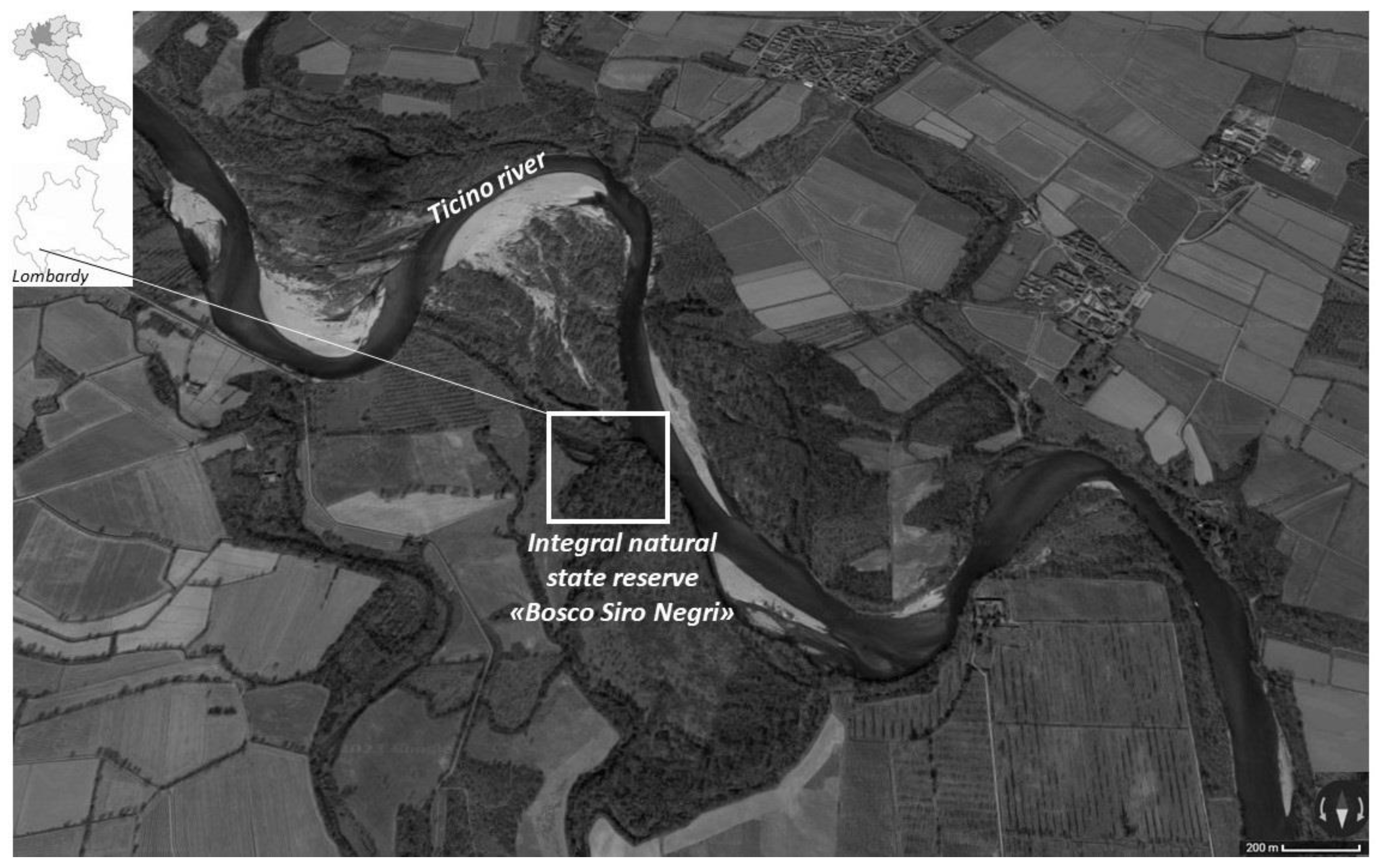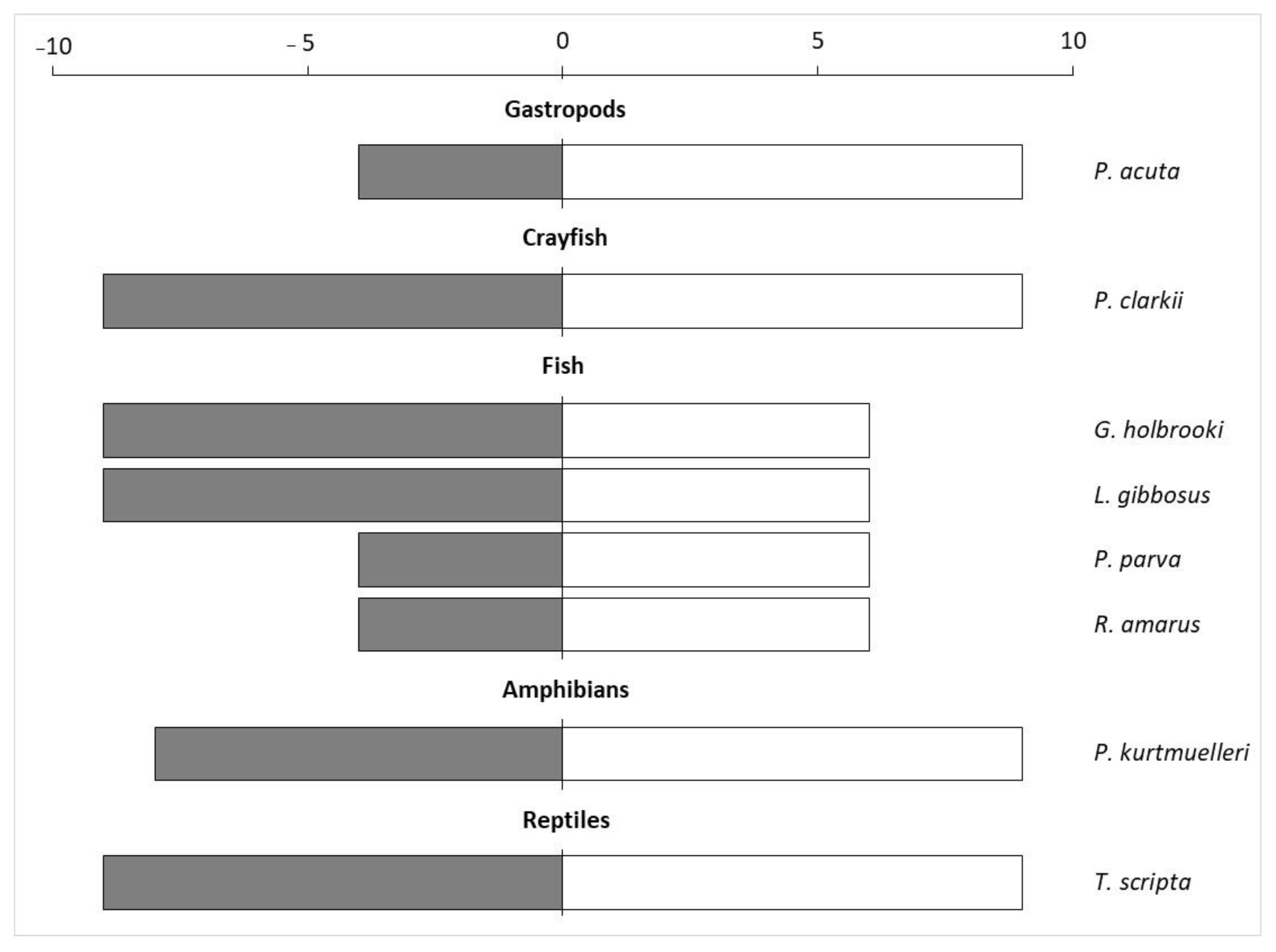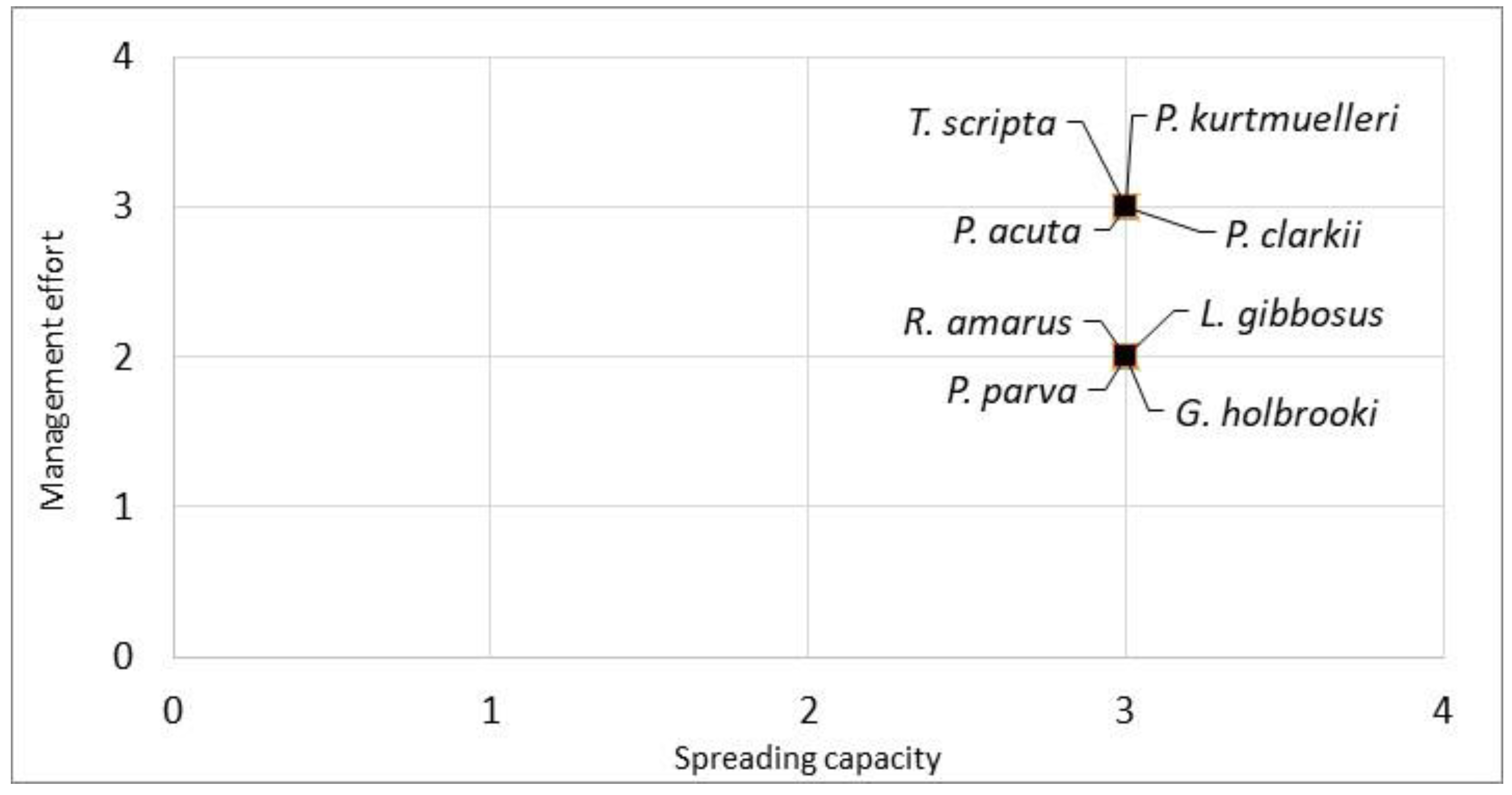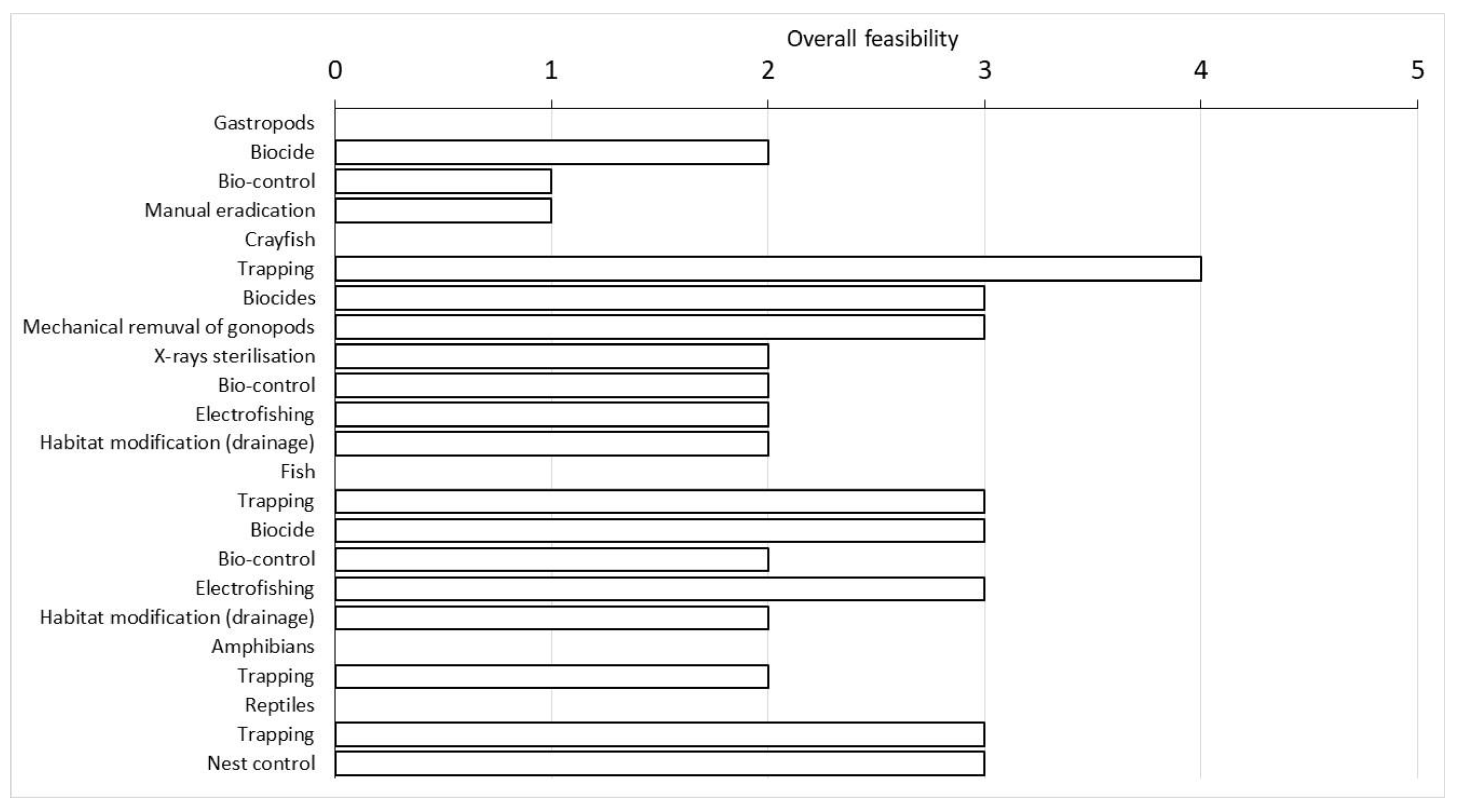Impacts, Potential Benefits and Eradication Feasibility of Aquatic Alien Species in an Integral Natural State Reserve
Abstract
Simple Summary
Abstract
1. Introduction
2. Materials and Methods
2.1. Study Area
2.2. Target Species
2.3. Assessment Methods
3. Results
4. Discussion
5. Conclusions
Supplementary Materials
Author Contributions
Funding
Institutional Review Board Statement
Informed Consent Statement
Data Availability Statement
Conflicts of Interest
References
- European Commission. EU Biodiversity Strategy for 2030, 1st ed.; Publications Office of the European Union: Luxembourg, 2021; 35p. [Google Scholar]
- Foxcroft, L.C.; Pyšek, P.; Richardson, D.M. Chapter 2: The bottom line: Impacts of alien plant invasions in protected areas. In Plant Invasions in Protected Areas: Patterns, Problems and Challenges; Foxcroft, L.C., Pyšek, P., Richardson, D.M., Genovesi, P., Eds.; Springer: Dordrecht, The Netherlands, 2014; pp. 19–41. [Google Scholar]
- Gardner, A.S.; Baker, D.J.; Mosedale, J.R.; Gaston, K.J.; Maclean, I.M.D. The effectiveness of UK protected areas in preventing local extinctions. Conserv. Lett. 2023, 16, e12980. [Google Scholar] [CrossRef]
- Schlaepfer, M.A.; Sax, D.F.; Olden, J.D. The potential conservation value of non-native species. Conserv. Biol. 2010, 25, 428–437. [Google Scholar] [CrossRef]
- Monaco, A.; Genovesi, P. European Guidelines on Protected Areas and Invasive Alien Species; Council of Europe: Strasbourg, France; Regional Parks Agency: Rome, Italy, 2014. [Google Scholar]
- Spear, D.; Foxcroft, L.C.; Bezuidenhout, H.; McGeoch, M.A. Human population density explains alien species richness in protected areas. Biol. Conserv. 2013, 159, 137–147. [Google Scholar] [CrossRef]
- Bacher, S.; Blackburn, T.M.; Essl, F.; Genovesi, P.; Heikkilä, J.; Jeschke, J.M.; Jones, G.; Keller, R.; Kenis, M.; Kueffer, C.; et al. Socio-economic impact classification of alien taxa (SEICAT). Methods Ecol. Evol. 2018, 9, 159–168. [Google Scholar] [CrossRef]
- Diagne, C.; Catford, J.; Essl, F.; Nuñez, M.; Courchamp, F. What are the economic costs of biological invasions? A complex topic requiring international and interdisciplinary expertise. NeoBiota 2020, 63, 1–25. [Google Scholar] [CrossRef]
- Diagne, C.; Leroy, B.; Gozlan, R.E.; Vaissiere, A.C.; Assailly, C.; Nuninger, L.; Roiz, D.; Jourdain, F.; Jarić, I.; Courchamp, F. INVACOST: A public database of the economic costs of biological invasions worldwide. Sci. Data 2020, 7, 277. [Google Scholar] [CrossRef] [PubMed]
- Diagne, C.; Leroy, B.; Vaissière, A.C.; Gozlan, R.E.; Roiz, D.; Jarić, I.; Salles, J.M.; Bradshaw, C.J.A.; Courchamp, F. High and rising economic costs of biological invasions worldwide. Nature 2021, 592, 571–576. [Google Scholar] [CrossRef]
- Haubrock, P.J.; Cuthbert, R.N.; Tricarico, E.; Diagne, C.; Courchamp, F.; Gozlan, R.E. The recorded economic costs of alien invasive species in Italy. NeoBiota 2021, 67, 247–266. [Google Scholar] [CrossRef]
- Spangenberg, J.H.; Settele, J. Precisely incorrect? Monetising the value of ecosystem services. Ecol. Complex. 2019, 7, 327–337. [Google Scholar] [CrossRef]
- La Posta, A.; Duprè, E. Italian National Biodiversity Strategy; Ministero dell’Ambiente e della Tutela del Territorio e del Mare: Rome, Italy, 2010; pp. 1–120. [Google Scholar]
- Britton, J.R.; Lynch, A.J.; Bardal, H.; Bradbeer, S.J.; Coetzee, J.A.; Coughlan, N.E.; Dalu, T.; Tricarico, E.; Gallardo, B.; Lintermans, M.; et al. Preventing and controlling nonnative species invasions to bend the curve of global freshwater biodiversity loss. Environ. Rev. 2023, 31, 310–326. [Google Scholar] [CrossRef]
- Genovesi, P. Guidelines for Eradication of Terrestrial Vertebrates: A European Contribution to the Invasive Alien Species Issue; Council of Europe: Strasbourg, France, 2000; p. tpvs65e-2000. [Google Scholar]
- Booy, O.; Mill, A.C.; Roy, H.E.; Hiley, A.; Moore, N.; Robertson, P.; Baker, S.; Brazier, M.; Bue, M.; Bullock, R.; et al. Risk management to prioritise the eradication of new and emerging invasive non-native species. Biol. Invasions 2017, 19, 2401–2417. [Google Scholar] [CrossRef]
- Booy, O.; Robertson, P.A.; Moore, N.; Ward, J.; Roy, H.E.; Adriaens, T.; Shaw, R.; Van Valkenburg, J.; Wyn, G.; Bertolino, S.; et al. Using structured eradication feasibility assessment to prioritize the management of new and emerging invasive alien species in Europe. Glob. Chang. Biol. 2020, 26, 6235–6250. [Google Scholar] [CrossRef] [PubMed]
- Albert, C.; Luque, G.M.; Courchamp, F. The twenty most charismatic species. PLoS ONE 2018, 13, e0199149. [Google Scholar] [CrossRef] [PubMed]
- Jarić, I.; Courchamp, F.; Correia, R.A.; Crowley, S.L.; Essl, F.; Fischer, A.; González-Moreno, P.; Kalinkat, G.; Lambin, X.; Lenzner, B.; et al. The role of species charisma in biological Invasions. Front. Ecol. Environ. 2020, 18, 345–353. [Google Scholar] [CrossRef]
- Horsley, S.; Hohbein, R.; Morrow, K.; Green, G.T. What’s in a name? A content analysis of environmental NGOs’ use of “iconic species” in press releases. Biodivers. Conserv. 2020, 29, 2711–2728. [Google Scholar] [CrossRef]
- Martinez-Cillero, R.; Willcock, S.; Perez-Diaz, A.; Joslin, E.; Vergeer, P.; Peh, K.S.-H. A practical tool for assessing ecosystem services enhancement and degradation associated with invasive alien species. Ecol. Evol. 2019, 9, 3918–3936. [Google Scholar] [CrossRef] [PubMed]
- Roy, H.; Schonrogge, K.; Dean, H.; Peyton, J.; Branquart, E.; Vanderhoeven, S.; Copp, G.; Stebbing, P.; Kenis, M.; Rabitsch, W.; et al. Invasive Alien Species—Framework for the Identification of Invasive Alien Species of EU Concern (ENV.B.2/ETU/2013/0026); European Commission: Brussels, Belgium, 2014; p. 298. [Google Scholar]
- Tassin, J.; Kull, C.A. Facing the broader dimensions of biological invasions. Land Use Policy 2015, 42, 165–169. [Google Scholar] [CrossRef]
- Cuthbert, R.N.; Pattison, Z.; Taylor, N.G.; Verbrugge, L.; Diagne, C.; Ahmed, D.A.; Leroy, B.; Angulo, E.; Briski, E.; Capinha, C.; et al. Global economic costs of aquatic invasive alien species. Sci. Total Environ. 2021, 775, 145238. [Google Scholar] [CrossRef]
- Jarić, I.; Correia, R.A.; Brook, B.W.; Buettel, J.C.; Courchamp, F.; Di Minin, E.; Firth, J.A.; Gaston, K.J.; Jepson, P.; Kalinkat, G.; et al. iEcology: Harnessing large online resources to generate ecological insights. Trends Ecol. Evol. 2020, 35, 630–639. [Google Scholar] [CrossRef]
- Gheza, G.; Nascimbene, J.; Barcella, M.; Bracco, F.; Assini, S. Epiphytic lichens of woodland habitats in the lower Ticino river valley and in the “Bosco Siro Negri” Integral Nature State Reserve (NW Italy). Nat. Hist. Sci. 2022, 9, 7–18. [Google Scholar] [CrossRef]
- Castagneri, D.; Garbarino, M.; Nola, P. Host preference and growth patterns of ivy (Hedera helix L.) in a temperate alluvial forest. Plant Ecol. 2013, 214, 1–9. [Google Scholar] [CrossRef]
- Savini, D. Rinvenimento della specie aliena invasiva Procambarus clarkii (Astacidea: Cambaridae) nella riserva naturale “Bosco Siro Negri” (Zerbolò—Pavia). Acta Biol. 2007, 83, 33–37. [Google Scholar]
- Haines-Young, R.; Potschin, M. Common international classification of ecosystem services (CICES, Version 4.1). Eur. Environ. Agency 2012, 33, 107. [Google Scholar]
- Reid, W.; Mooney, H.; Cropper, A.; Capistrano, D.; Carpenter, S.; Chopra, K. Millennium Ecosystem Assessment. Ecosystems and Human Well-Being: Synthesis; Island Press: Washington, DC, USA, 2005; pp. 1–87. [Google Scholar]
- The Economics of Ecosystem and Biodiversity (TEEB). Ecosystem Services; TEEB: USA, 2016; Available online: http://www.teebweb.org/resources/ecosystem-services/ (accessed on 15 November 2023).
- Mastrandrea, M.D.; Field, C.B.; Stocker, T.F.; Edenhofer, O.; Ebi, K.L.; Frame, D.J.; Held, H.; Kriegler, E.; Mach, K.J.; Matschoss, P.R.; et al. Guidance Note for Lead Authors of the IPCC Fifth Assessment Report on Consistent Treatment of Uncertainties; Intergovernmental Panel on Climate Change (IPCC): Geneva, Switzerland, 2010. [Google Scholar]
- FAO. Guidelines for Pest Risk Analysis. International Standards for Phytosanitary Measures (ISPM). No. 2; Food and Agriculture Organization of the United Nations: Rome, Italy, 2005; p. 38. [Google Scholar]
- FAO. Phytosanitary Principles for the Protection of Plants and the Application of Phytosanitary Measures in International Trade. International Standards for Phytosanitary Measures (ISPM). No. 1; Food and Agriculture Organization of the United Nations: Rome, Italy, 2016; p. 14. [Google Scholar]
- OIE. Aquatic Animal Health Code World Organisation for Animal Health—Protecting Animals, Preserving Our Future, 22nd ed.; World Organisation for Animal Health: Paris, France, 2019; p. 324. [Google Scholar]
- Mumford, J.; Booy, O.; Baker, R.; Rees, M.; Copp, G.H.; Black, K.; Holt, J.; Leach, A.W.; Hartley, M. Invasive non-native species risk assessment in Great Britain. Asp. Appl. Biol. 2010, 104, 49–54. [Google Scholar]
- Baker, R.H.A.; Benninga, J.; Bremmer, J.; Brunel, S.; Dupin, M.; Eyre, D.; Ilieva, Z.; Jaros, V.; Kehlenbeck, H.; Kriticos, D.J.; et al. A decision support scheme for mapping endangered areas in pest risk analysis. EPPO Bull. 2012, 42, 65–73. [Google Scholar] [CrossRef]
- Blackburn, T.M.; Essl, F.; Evans, T.; Hulme, P.E.; Jeschke, J.M.; Kühn, I.; Kumschick, S.; Marková, Z.; Mrugala, A.; Nentwig, W.; et al. A unified classification of alien species based on the magnitude of their environmental impacts. PLoS Biol. 2014, 12, e1001850. [Google Scholar] [CrossRef]
- Ficetola, F.G.; Siesa, M.E.; Manenti, R.; Bottoni, L.; De Bernardi, F.; Padoa-Schioppa, E. Early assessment of the impact of alien species: Differential consequences of an invasive crayfish on adult and larval amphibians. Diver. Distrib. 2011, 17, 1141–1151. [Google Scholar] [CrossRef]
- García-Berthou, E.; Moreno-Amich, R. Food of introduced pumpkinseed sunfish: Ontogenetic diet shift and seasonal variation. J. Fish Biol. 2000, 57, 29–40. [Google Scholar] [CrossRef]
- Global Invasive Species Database. Species Profile: Gambusia affinis. 2023. Available online: http://www.iucngisd.org/gisd/species.php?sc=126 (accessed on 10 October 2023).
- Nunes, A.L.; Fill, J.M.; Davies, S.J.; Louw, M.; Rebelo, A.D.; Thorp, C.J.; Vimercati, G.; Measey, J. A global meta-analysis of the ecological impacts of alien species on native amphibians. Proc. R. Soc. B 2019, 286, 20182528. [Google Scholar] [CrossRef]
- Holsbeek, G.; Jooris, R. Potential impact of genome exclusion by alien species in the hybridogenetic water frogs (Pelophylax esculentus complex). Biol. Invasions 2010, 12, 1–13. [Google Scholar] [CrossRef]
- Longshaw, M.; Bateman, K.S.; Stebbing, P.; Stentiford, G.D.; Hockley, F.A. Disease risks associated with the importation and release of non-native crayfish species into mainland Britain. Aquat. Biol. 2012, 16, 1–15. [Google Scholar] [CrossRef]
- Berger, L.; Roberts, A.A.; Voyles, J.; Longcore, J.E.; Murray, C.A.; Skerratt, L.F. History and recent progress on chytridiomycosis in amphibians. Fungal Ecol. 2016, 19, 89–99. [Google Scholar] [CrossRef]
- Hanley, N.; Roberts, M. The economic benefits of invasive species management. People Nat. 2019, 1, 124–137. [Google Scholar] [CrossRef]
- Kahrs, D. American bullfrog eradication in Sycamore Canyon, Arizona, a natural open aquatic system. Son. Herpetol. 2006, 19, 74–77. [Google Scholar]
- Lemmens, P.; Mergeay, J.; Vanhove, T.; De Meester, L.; Declerck, S.A.J. Suppression of invasive topmouth gudgeon Pseudorasbora parva by native pike Esox lucius in ponds. Aquat. Conserv. Mar. Freshw. Ecosyst. 2015, 25, 41–48. [Google Scholar] [CrossRef]
- Ballinger, A. ‘Procambarus clarkii (Red Swamp Crayfish)’, CABI Compendium; CABI International: Wallingford, UK, 2022. [Google Scholar] [CrossRef]
- Manfrin, C.; Souty-Grosset, C.; Anastácio, P.M.; Reynolds, J.; Giulianini, P.G. Detection and control of invasive freshwater crayfish: From traditional to innovative methods. Diversity 2019, 11, 5. [Google Scholar] [CrossRef]
- Manfrin, C.; Giglio, A.; Pallavicini, L.; Zampa, L.; Vecchiet, L.; Caputi, A.; Chiandetti, C.; Beorchia, A.; Vidimari, R.; Giulianini, P.G. Medium-term feasibility of the management of the invasive crayfish Procambarus clarkii with the sterile males release technique. Pest Manag. Sci. 2021, 77, 2494–2501. [Google Scholar] [CrossRef]
- Green, N.; Britton, J.R.; Bentley, M.; Stebbing, P.; Andreou, D. Dominance, reproductive behaviours and female mate choice in sterilised versus non-sterilised invasive male crayfish. Aquat. Ecol. 2020, 54, 813–822. [Google Scholar] [CrossRef]
- Green, N.; Andreou, D.; Bentley, M.; Stebbing, P.; Hart, A.; Britton, J.R. Mechanical male sterilisation in invasive signal crayfish Pacifastacus leniusculus: Persistence and functionality in captive and wild conditions. Know. Manag. Aquat. Ecosyst. 2022, 423, 20. [Google Scholar] [CrossRef]
- Johović, I.; Verrucchi, C.; Inghilesi, A.F.; Scapini, F.; Tricarico, E. Managing the invasive crayfish Procambarus clarkii: Is manual sterilisation the solution? Freshw. Biol. 2020, 65, 621–631. [Google Scholar] [CrossRef]
- Martin, C.W.; Bahya, K.M.; Valentine, J.F. Establishment of the Invasive Island Apple Snail Pomacea insularum (Gastropoda: Ampullaridae) and Eradication Efforts in Mobile, Alabama, USA. Gulf Mex. Sci. 2012, 30, 5. [Google Scholar] [CrossRef]
- Gili, C. Ligurian Invasive Fauna Eradication Pro-Indigenous Emys orbicularis Restocking. LIFEEMYS—LIFE 12 NAT/IT/000395, 2018. Available online: https://webgate.ec.europa.eu/life/publicWebsite/project/LIFE12-NAT-IT-000395/ligurian-invasive-fauna-eradication-pro-indigenous-emys-orbicularis-restocking (accessed on 23 June 2023).
- Sancho Alcayde, V.; Lacomba Andueza, J.L.; Bataller Gimeno, J.V.; Pradillo Carrasco, A. Manual para el Control y Erradicación de Galápagos Invasores. Colección Manuales Técnicos de Biodiversidad, 6; Conselleria d’Agricultura, Medi Ambient, Canvi Climàtic i Desenvolupament Rural, Generalitat Valenciana: Valencia, Spain, 2015; p. 78. [Google Scholar]
- Myers, J.H.; Simberloff, D.; Kuris, A.M.; Carey, J.R. Eradication revisited: Dealing with exotic species. Trends Ecol. Evol. 2000, 15, 316–320. [Google Scholar] [CrossRef] [PubMed]
- Myers, J.H.; Savoie, A.; van Randen, E. Eradication and pest management. Annu. Rev. Entomol. 1998, 43, 471–491. [Google Scholar] [CrossRef]
- Paganelli, D.; Reino, L.; Capinha, C.; Ribeiro, J. Exploring expert perception of protected areas’ vulnerability to biological invasions. J. Nat. Conserv. 2021, 62, 126008. [Google Scholar] [CrossRef]
- Hummel, C.; Poursanidis, D.; Orenstein, D.; Elliot, M.; Adamescu, M.C.; Cazacu, C.; Ziv, G.; Chrysoulakis, N.; van der Meer, J.; Hummel, H. Protected Area management: Fusion and confusion with the ecosystem services approach. Sci. Total Environ. 2019, 651, 2432–2443. [Google Scholar] [CrossRef] [PubMed]





| Eradication Strategy/Risk Management | Effectiveness | Praticality | Costs | Impacts | Acceptability | Window of Opportunity | Likelihood of Reinvasion | Overall Feasibility | Overall Confidence |
|---|---|---|---|---|---|---|---|---|---|
| Gastropods (P. acuta) | |||||||||
| Biocide | 3 | 4 | N.A. | 2 | 4 | 1 | 1 | 2 | H |
| Biocontrol (predators) | 1 | 3 | N.A. | 2 | 2 | 1 | 1 | 1 | H |
| Manual eradication | 1 | 1 | N.A. | 5 | 5 | 1 | 1 | 1 | H |
| Crayfish (P. clarkii) | |||||||||
| Trapping | 4 | 5 | 5 | 5 | 5 | 3 | 3 | 4 | H |
| Chemical/biocides | 4 | 3 | 5 | 2 | 4 | 3 | 3 | 3 | H |
| Mechanical removal of gonopods | 3 | 3 | 5 | 5 | 5 | 3 | 3 | 3 | H |
| X-rays sterilisation | 4 | 2 | N.A. | 5 | 5 | 3 | 3 | 2 | H |
| Biocontrol | 3 | 3 | 5 | 2 | 5 | 3 | 3 | 2 | H |
| Electro fishing | 2 | 3 | 5 | 2 | 4 | 3 | 3 | 2 | H |
| Habitat modification (drainage) | 2 | 1 | N.A. | 1 | 2 | 3 | 3 | 2 | H |
| Fish (L. gibbosus; P. parva; R. amaro) | |||||||||
| Trapping | 4 | 4 | 5 | 5 | 5 | 3 | 2 | 3 | H |
| Biocide | 4 | 3 | 5 | 2 | 3 | 3 | 2 | 3 | H |
| Biocontrol (genetic) | 4 | 3 | N.A. | 3 | 3 | 3 | 2 | 2 | M |
| Electro fishing | 3 | 3 | 5 | 2 | 4 | 3 | 2 | 3 | H |
| Habitat modification (drainage) | 5 | 1 | N.A. | 1 | 2 | 3 | 2 | 2 | H |
| Amphibians (P. kurtmuelleri) | |||||||||
| Trapping/removal | 3 | 4 | 4 | 4 | 4 | 2 | 2 | 2 | M |
| Reptiles (T. scripta) | |||||||||
| Trapping | 4 | 4 | 4 | 5 | 5 | 3 | 2 | 3 | H |
| Nest control | 3 | 4 | 5 | 4 | 4 | 3 | 2 | 3 | H |
Disclaimer/Publisher’s Note: The statements, opinions and data contained in all publications are solely those of the individual author(s) and contributor(s) and not of MDPI and/or the editor(s). MDPI and/or the editor(s) disclaim responsibility for any injury to people or property resulting from any ideas, methods, instructions or products referred to in the content. |
© 2024 by the authors. Licensee MDPI, Basel, Switzerland. This article is an open access article distributed under the terms and conditions of the Creative Commons Attribution (CC BY) license (https://creativecommons.org/licenses/by/4.0/).
Share and Cite
Paganelli, D.; Bellati, A.; Gazzola, A.; Bracco, F.; Pellitteri-Rosa, D. Impacts, Potential Benefits and Eradication Feasibility of Aquatic Alien Species in an Integral Natural State Reserve. Biology 2024, 13, 64. https://doi.org/10.3390/biology13010064
Paganelli D, Bellati A, Gazzola A, Bracco F, Pellitteri-Rosa D. Impacts, Potential Benefits and Eradication Feasibility of Aquatic Alien Species in an Integral Natural State Reserve. Biology. 2024; 13(1):64. https://doi.org/10.3390/biology13010064
Chicago/Turabian StylePaganelli, Daniele, Adriana Bellati, Andrea Gazzola, Francesco Bracco, and Daniele Pellitteri-Rosa. 2024. "Impacts, Potential Benefits and Eradication Feasibility of Aquatic Alien Species in an Integral Natural State Reserve" Biology 13, no. 1: 64. https://doi.org/10.3390/biology13010064
APA StylePaganelli, D., Bellati, A., Gazzola, A., Bracco, F., & Pellitteri-Rosa, D. (2024). Impacts, Potential Benefits and Eradication Feasibility of Aquatic Alien Species in an Integral Natural State Reserve. Biology, 13(1), 64. https://doi.org/10.3390/biology13010064








